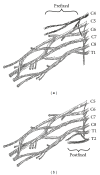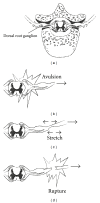Brachial plexus injuries in adults: evaluation and diagnostic approach
- PMID: 24967130
- PMCID: PMC4045362
- DOI: 10.1155/2014/726103
Brachial plexus injuries in adults: evaluation and diagnostic approach
Abstract
The increased incidence of motor vehicle accidents during the past century has been associated with a significant increase in brachial plexus injuries. New imaging studies are currently available for the evaluation of brachial plexus injuries. Myelography, CT myelography, and magnetic resonance imaging (MRI) are indicated in the evaluation of brachial plexus. Moreover, a series of specialized electrodiagnostic and nerve conduction studies in association with the clinical findings during the neurologic examination can provide information regarding the location of the lesion, the severity of trauma, and expected clinical outcome. Improvements in diagnostic approaches and microsurgical techniques have dramatically changed the prognosis and functional outcome of these types of injuries.
Figures







References
-
- Snell RS. Clinical Anatomy. 8th edition. Lippincott Williams & Wilkins; 2007.
-
- Kerr A. Brachial plexus of nerves in man. The variations in its formation and branches. American Journal of Anatomy. 1918;23(article 285)
-
- Uysal II, Şeker M, Karabulut AK, et al. Brachial plexus variations in human fetuses. Neurosurgery. 2003;53(3):676–684. - PubMed
-
- Senecail B. Le plexus brachial de l’Homme [Ph.D. thesis] 1975.
-
- Adolphi H. Uber das Verhalten der zweiten Brustnerven zum plexus brachialis beim Menschen. Anatomischer Anzeiger. 1898;15:25–36.
Publication types
LinkOut - more resources
Full Text Sources
Other Literature Sources
Miscellaneous
